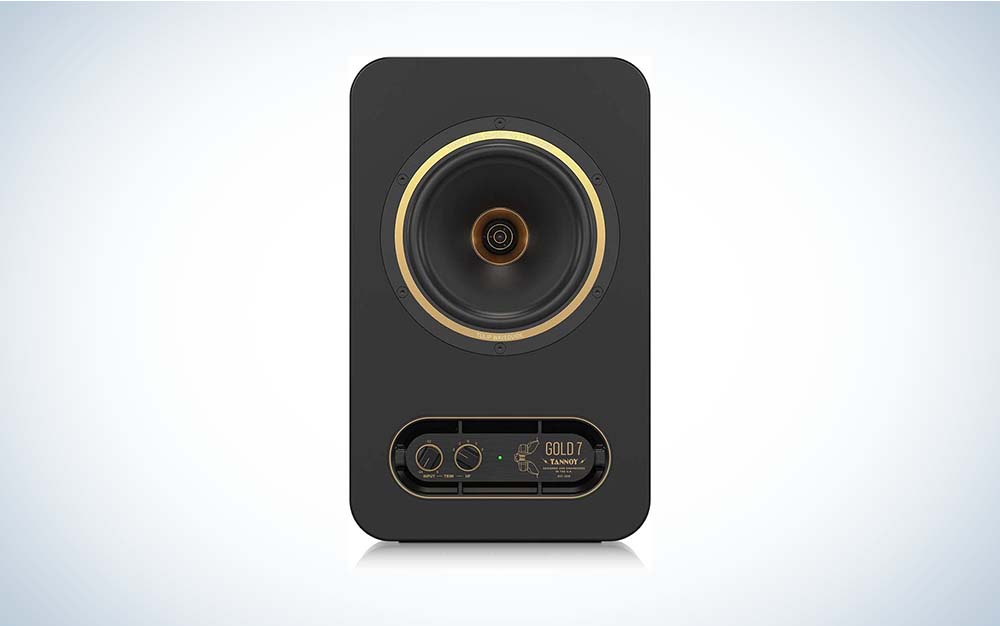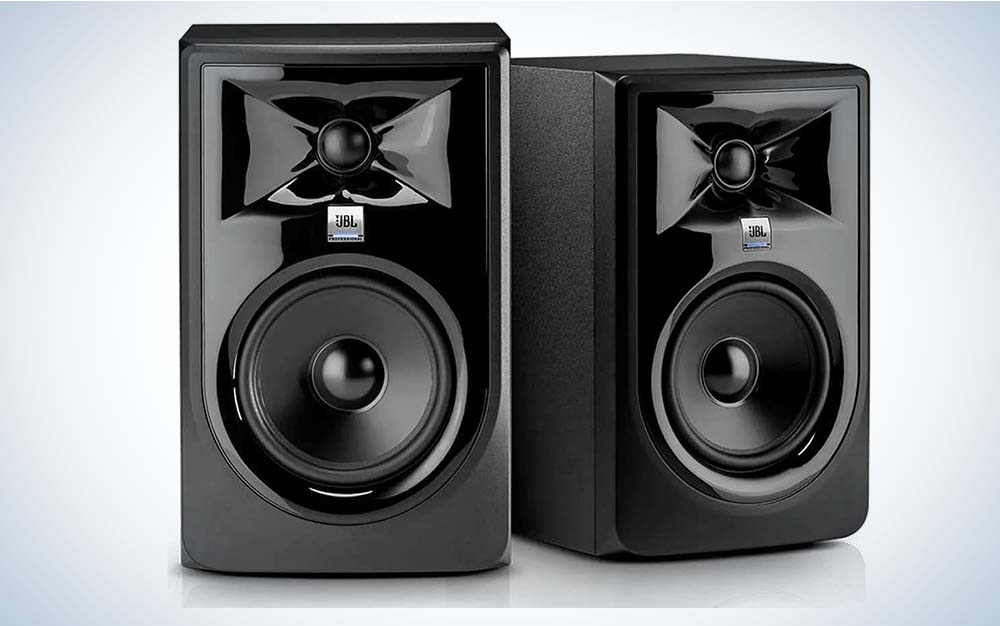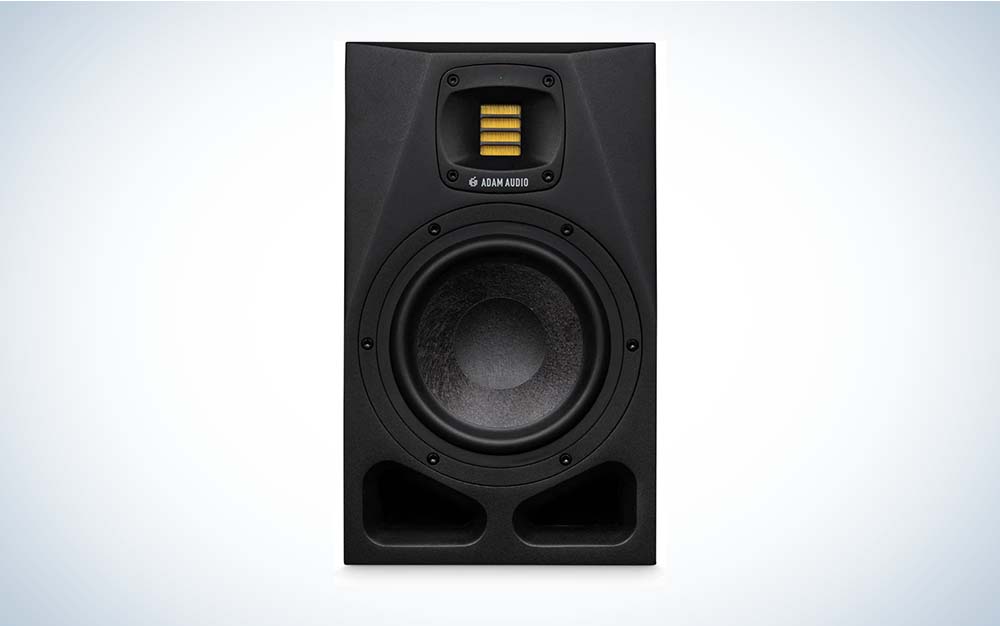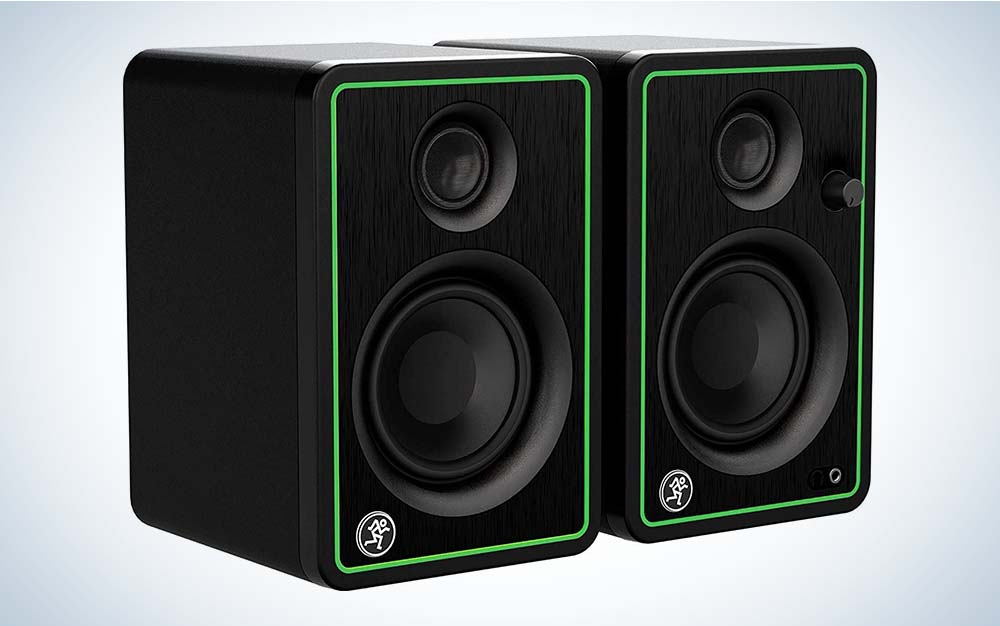
Studio monitors are the speakers of choice for mixing and mastering engineers, due to their clinical and accurate sound that’s ideal for critical audio editing tasks. Unlike most bookshelf speakers and hi-fi stereo systems that are designed to sound as full and flattering as possible, studio monitors are meticulously engineered to provide a very neutral and unaffected picture of the source audio to help artists create a final product that will translate to many different sound systems.
Studio monitors come in a wide range of price tiers, and some offer basic extras like Bluetooth connectivity, as well as more advanced features like custom room EQ adjustment. In this article, we’ll walk you through the best studio monitors for every space and outline a few things to look for when choosing yours.
— Best Overall: Tannoy GOLD 7
— Best Small: PreSonus Eris E3.5 BT
— Best for Home: JBL 305P MkII
— Best Professional: ADAM Audio A7V
— Best Budget: Mackie CR3-X
How We Chose the Best Studio Monitors
We narrowed down our list of studio monitors using a blend of hands-on testing and real-world reviews, alongside important factors like brand, size, design, and connectivity.
Brand: Brand reputation is a big factor in the pro audio world, and we opted to prioritize brands like JBL and Tannoy that have a proven track record of producing high-quality audio products. A number of the studio monitors on this list are also updated and improved versions of previous models.
Size: A studio monitor’s size directly affects its sound, and we aimed to include a range of sizes that will accommodate most uses. Generally, the smaller the studio monitor, the less bass response it offers. Buying a larger studio monitor will offer a more well-rounded sound at the expense of space, but small studio monitors can also be augmented with the addition of a subwoofer that can be kept on the floor.
Design: Every company has their own techniques and tricks for designing a neutral-sounding, high-quality studio monitor, and our list reflects this wide variety of options. In addition to more traditional designs, we’ve included a model that uses unconventional materials in its drivers to add extended frequency response, and another that stacks its drivers together to create a wider sweet spot.
Connectivity: Most of the studio monitors on this list are compatible with the industry-standard XLR connector for audio input, but some of our choices also include connectivity via TRS, 3.5-millimeter minijack, RCA, and even Bluetooth.
The Best Studio Monitors: Reviews and Recommendations
Best Overall: Tannoy GOLD 7

Why It Made the Cut: The Tannoy GOLD 7 delivers a level of stereo imaging performance and sonic precision rarely found in its price range, with stunning looks to match.
Specs:
— Driver Size: 6.5-inch LF, 1-inch HF
— Total Power: 300 watts
— Frequency Response: 65Hz to 20kHz (±3dB [decibels]), 46 Hz to 20 kHz (-10dB)
— Dimensions: 14.0 inches H x 8.7 inches W x 11.3 inches D
— Weight: 20.7 pounds
Pros:
— Unique dual-concentric design
— Fantastic stereo imaging and soundstage with a wide sweet spot
— 300-watt class AB amplifiers deliver lots of clean volume
— Auto standby mode saves power when not in use
Cons:
— Slight mid-bass frequency emphasis
— No magnetic shielding
— Produces some hiss at full gain
— Price is for one speaker, not two
The meticulously-engineered Tannoy GOLD 7 studio monitor delivers some of the best overall sound and performance in its price and size range, thanks to the powerful amplifiers and unique dual-concentric driver design. Sitting in between the size and power of the GOLD 5 and GOLD 8 models, the GOLD 7 features a 6.5-inch woofer and a 1-inch tweeter powered by 300 watts of class AB amplification power, allowing it to deliver an above-average amount of headroom volume and clean, distortion-free audio. Unlike studio monitors that space apart their high-frequency and low-frequency components, the Tannoy GOLD 7’s coaxial design stacks the two elements together, ensuring that all sound comes from a single point and minimizing the potential for phasing issues. The end result of this configuration is a stylish and streamlined studio monitor with a much wider listening “sweet spot” and improved stereo imaging, making it suitable for a range of studio sizes and types.
Tonally, the Tannoy GOLD 7 studio monitor is balanced and precise with extended lows and highs, a very detailed midrange, and a slightly exaggerated mid-bass thump. This makes it a fantastic choice for mixing and mastering applications, as well as normal hi-fi audio listening use. The GOLD 7 can be a bit noisy at its highest gain settings, producing a small amount of audible hiss, but this can easily be remedied by lowering the input gain. Notably, none of the studio monitors in Tannoy’s GOLD line are magnetically shielded, but this shouldn’t be a problem unless you’re operating an old-school CRT computer monitor, hard drives, or other magnetic media, which should be kept at least a few inches away from the GOLD 7s out of an abundance of caution.
Best Small: PreSonus Eris E3.5 BT

Why They Made the Cut: The PreSonus Eris E3.5 BT are some of the most powerful and balanced studio monitors in their size range, and their Bluetooth connectivity makes them extra versatile.
Specs:
— Driver Size: 3.5-inch LF, 1-inch HF
— Total Power: 25 watts
— Frequency Response: 80 Hz to 20 kHz
— Dimensions: 8.3 inches H x 5.6 inches W x 6.4 inches D
— Weight: 3.2 pounds
Pros:
— Clear and powerful audio in a small space-friendly package
— Treble and bass equalizer knobs offer ±6dB of adjustment
— Relatively flat and neutral frequency response suitable for editing work
— Bluetooth-compatible for streaming audio from devices
Cons:
— Lacks sub-bass response required for some audio editing
— Included light-gauge wire for linking speakers is flimsy
— Good build quality, but would be nice if it were sturdier
Mixing in small spaces can be a daunting task due to the performance limitations of small speakers, but the compact PreSonus Eris E3.5 BT studio monitors manage to serve up surprisingly balanced sound and plenty of power in their pint-sized design. They have a relatively neutral and honest sonic profile that makes them suitable for critical audio editing, and because they weigh only 3.2 pounds each, they’re easy to bring along when you take your mixing rig on the road. The Eris E3.5 BTs also feature Bluetooth connectivity — a feature rarely found in studio monitors — giving them an edge over traditional Bluetooth speakers for casual listening when sound quality matters.
While they sound incredibly nuanced for a 3.5-inch studio monitor, the PreSonus Eris E3.5 BTs do suffer from a lack of sub-bass reproduction that’s typical of speakers this size. Rear treble and bass EQ knobs allow users to make some fine adjustments, but if they’ll be used as a primary mixing setup, adding a compact subwoofer like the Eris Sub 8 will make the system better suited for making final editing decisions. Certain components like their cabinets and wiring can also feel a bit fragile during handling due to their lightweight design, but this doesn’t affect their overall performance; they’re still the best small option out there in terms of their clarity, volume, and flat profile.
Best for Home: JBL 305P MkII

Why They Made the Cut: The JBL 305P MkIIs feature ample power and clear, accurate sound at a price and size that’s ideal for home studios.
Specs:
— Driver Size: 5-inch LF, 1-inch HF
— Total Power: 82 watts
— Frequency Response: 49Hz to 20kHz (±3dB), 43Hz to 24kHz (-10dB)
— Dimensions: 11.75 inches H x 7.3 inches W x 9.9 inches D
— Weight: 10.43 pounds
Pros:
— Tight, detailed bass response with an overall flat sound profile
— Boundary EQ compensates for placement near walls and tabletops
— Clean signal at a range of volumes with low distortion
Cons:
— Produces small amount of hiss at full gain
— Shiny finish is hard to keep clean
— Lack adequate bass response at longer distances
If you’re looking for a studio monitor that will help you make great mixes at home, the JBL 305P MkII’s well-balanced combination of clarity and power makes it perfect for the job. As the current revision of the JBL LSR305, the 305P MkIIs offer the same neutral and flat nearfield performance as their predecessor, with the added bonus of a boundary EQ adjustment feature that allows users to adjust the speakers’ sound when placed on nearby walls or desktops. When considered alongside the JBL 305P MkII’s tight bass response and overall flat sonic profile, this boundary EQ gives them a healthy edge over the competition in less-than-ideal settings where space is in short supply. Their HF and LF drivers have also been updated to deliver noticeably tighter bass and transient response, along with lower distortion. They also feature a new glossy finish that’s undeniably stylish, but can also be a bit of a dust magnet.
The 305P MkII’s 82 watts of amplification power and 5-inch woofers push plenty of air when used in home studios, but their volume and particularly their bass response begin to drop off at distances greater than 5 feet or so. If you’re working in a larger space and want a similar sonic profile with an appropriate amount of power and bass response, they can be paired with the LSR310S 10-inch subwoofer or swapped for their 8-inch sibling, the 308P MkII, depending on your specific needs. Like many powered speakers, the 305P MkII also produce some hiss when their input volume is pushed to the max, but this can be remedied by backing off the gain slightly.
Best Professional: ADAM Audio A7V

Why It Made the Cut: A unique combination of high-quality construction and cutting-edge software control make the ADAM Audio A7V a versatile studio monitor for every pro setting.
Specs:
— Driver Size: 7-inch LF, 2-inch HF
— Total Power: 130 watts
— Frequency Response: 44Hz to 41kHz (-3dB), 40Hz to 45kHz (-6dB)
— Dimensions: 13.25 inches H x 7.87 inches W x 11 inches D
— Weight: 19.18 pounds
Pros:
— Built-in room adaptation customizes sound for any space
— Ribbon tweeter greatly reduces high-end distortion for incredible clarity
— Very broad frequency response stretching up to 45kHz
Cons:
— Separate subwoofer required for adequate sub-bass performance
— Clinical and detailed sound may be unflattering for casual listening
Pivoting to professional studio monitors can be game-changing when you’re looking to mix, record, and master with the highest possible accuracy, but many other factors including room acoustics and signal chain can drastically affect the overall equation. For the money, the ADAM Audio A7V monitor offers the perfect balance of value and quality for a professional studio, and it’s some of the best professional sound available in the sub-$800 range.
Besides the great build quality and extremely wide frequency response, a big draw of the ADAM A7V is its unique built-in DSP room adaptation that automatically adjusts the studio monitor’s sound according to the exact acoustics of your space. This feature keeps it accurate across a variety of spaces, making it one of the most versatile studio monitors overall. Compared to the last-gen ADAM A7X, the A7V’s back panel is also more streamlined for manual controls and includes an Ethernet port to allow DSP sound adjustments straight from any computer.
Alongside the 7-inch woofer that offers plenty of bass, the ADAM A7V features a unique ribbon tweeter that allows it to deliver extreme high-frequency information up to around 45 kHz with very little distortion. Overall, this studio monitor’s sound is incredibly clinical and detailed which makes it great for critical use, but it’s also uniquely capable of revealing imperfections when playing audio from streaming apps or other compressed sources. As expected from any 7-inch studio monitor, the A7V doesn’t offer much sub-bass information and can be paired with a subwoofer like the ADAM T10S if you’re hankering for more.
Best Budget: Mackie CR3-X

Why They Made the Cut: The Mackie CR3-Xs offer lots of power, connectivity, and bass response in spite of their small size and basic design, making them a good starter or budget option for burgeoning studios.
Specs:
— Driver Size: 3-inch LF, 0.75-inch HF
— Total Power: 25 watts
— Frequency Response: 70Hz – 20kHz (-10dB), 80Hz – 20kHz (-3dB)
— Dimensions: 8.8 inches H x 5.5 inches W x 7.1 inches D
— Weight: 7.8 pounds
Pros:
— Versatile XLR, TRS, and 3.5-millimeter connectivity
— 50 total watts of power offer plenty of volume
— Built-in headphone output for streamlined setups
Cons:
— Slight audible hiss at a range of volumes
— Good bass response, but artificially boosted and can’t be bypassed
— Overall not as dynamic or sonically neutral as pricier competitors
Mackie’s miniscule 3-inch CR3-X studio monitors cost under $100 per pair and are one of the best budget options on the market, thanks to their powerful amplification and wealth of connectivity options. Like the PreSonus Eris E3.5 BT, the Mackie CR3-X monitors use a minimalist speaker wire to link the pair and pack a total of 50 watts of amplification, giving them ample volume abilities without taking up too much desk space. They feature XLR, TRS, and 3.5-millimeter input connections on the rear, as well as a front-panel headphone output that mutes both speakers when in use, eliminating the need for a separate audio interface when switching between headphone and speaker monitoring.
The CR3-Xs have a pronounced bass boost built right into their frequency curve that makes them particularly good for multimedia use despite their small size, but this deprives them of the ability to sound truly neutral and honest for critical use. They also produce a constant low-volume hiss that can be distracting when monitoring at lower volumes. They don’t perform quite as dynamically or free of distortion as more expensive studio monitors, but all things considered, these studio monitors are fantastic as a pair of starter or secondary studio monitors for reference purposes. You will, however, want to spend a little more if you’ll be making critical editorial decisions.
Things to Consider Before Buying a Studio Monitor
Your Workspace: Studio monitors should be sized roughly according to the size of your room and workspace. In general, small studio monitors like the PreSonus Eris E3.5 BT have 3- to 3.5-inch drivers and are perfect for working in spaces where every square inch matters. Mid-sized studio monitors like the Tannoy GOLD 7 and ADAM Audio A7V produce a wider range of frequencies and push more volume at the expense of desk space. If you have enough space for 7- or 8-inch studio monitors and you want to hear even more sub-bass, you can also add a subwoofer like the PreSonus Eris Sub 8 or ADAM T10S.
Usage: When you’re not editing audio or checking your mixes, studio monitors can be great for listening to other music, especially if you’re comparing your work-in-progress to a reference track. A well-balanced studio monitor with a frequency range between roughly 40Hz and 20kHz like the JBL 305P MkII or Tannoy GOLD 7 will be suitable for casual listening, but if your studio monitors offer an extended frequency response like the ADAM Audio A7V, they may reveal the limitations of compressed audio from MP3s or streaming services and sound unflattering.
Budget: Studio monitors come in a wide range of prices, and generally speaking, larger studio monitors cost more while smaller studio monitors cost less. For this reason, it’s important to consider your budget directly alongside your sound quality needs when buying studio monitors. If you’re looking for the best balance of size, price, and sound, the JBL 305P MkIIs also feature a 5-inch woofer and cost under $300 a pair.
FAQs
Studio monitors can cost anywhere from below $100 up to tens of thousands of dollars for a pair. As with most pro audio gear, it’s very easy to find a great pair of studio monitors without spending a fortune. You’re very unlikely to get the most out of higher-tier studio monitors unless you’re working in a room that has state-of-the-art acoustic treatment. Our budget pick, the Mackie CR3-X, costs under $100 and our pro pick, the ADAM A7V, costs just shy of $1,500 for a pair. Just to give you an idea of how much you can spend on studio monitors, the Barefoot Audio MasterStack12 will set you back around $60,000.
You can definitely listen to music on studio monitors, especially if it’s high-resolution loss-less audio. Studio monitors are way more detailed and nuanced than traditional listening systems, so certain forms of audio — especially compressed files like MP3s or music from streaming services — may sound a bit dull depending on how accurately your studio monitors perform.
Studio monitors should be recycled at your nearest e-waste recycling facility due to the heavy metals and other potentially hazardous materials used in their components. If you’re moving on from making music or just looking to upgrade to another model, consider selling or donating your studio monitors instead—unless they’re broken, it’s very likely that someone else can use them to make music. Also, be sure to check out our guide on how to recycle electronics.
Final Thoughts on the Best Studio Monitors
If you’re buying studio monitors for the first time or looking to upgrade your current monitoring setup, the Tannoy GOLD 7 offers some of the best overall performance and sound thanks to its wide sweet spot and very detailed midrange response. The PreSonus Eris E3.5 BTs are the best small studio monitors for traveling engineers, small spaces, and Bluetooth audio streaming, while the JBL 305P MkIIs offer more bass and are better for home studio use if you have the space. If you’re looking for a high-quality studio monitor for working in a variety of spaces and have a bit more to spend, the ADAM Audio A7V’s extended frequency response and room customization make it one of the best professional studio monitors currently available. Finally, if you’re shopping on a budget, the Mackie CR3-Xs are a solid option for beginning mixing duties or as a secondary pair.
This post was created by a non-news editorial team at Recurrent Media, Futurism’s owner. Futurism may receive a portion of sales on products linked within this post.